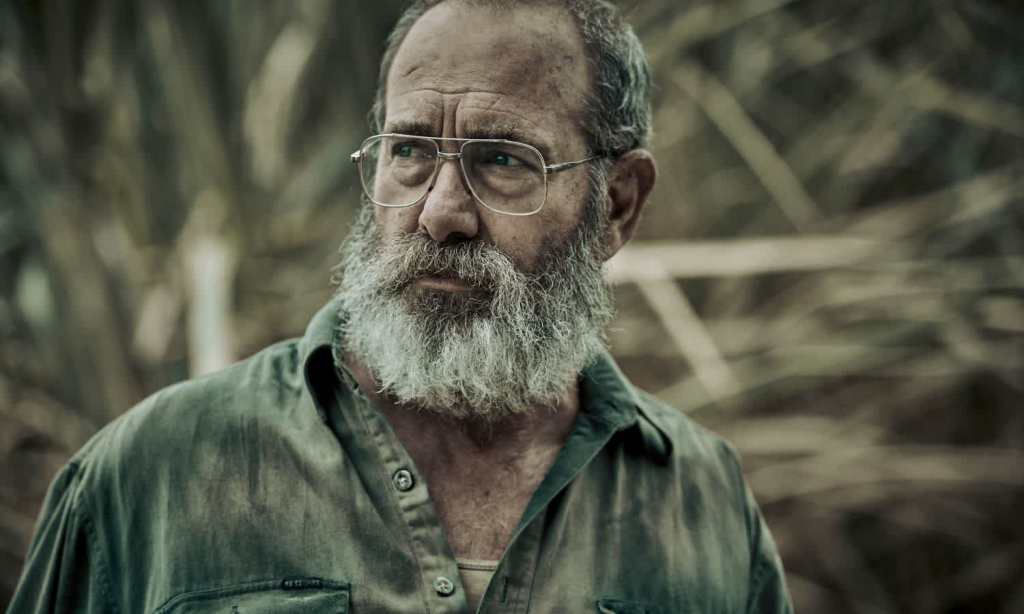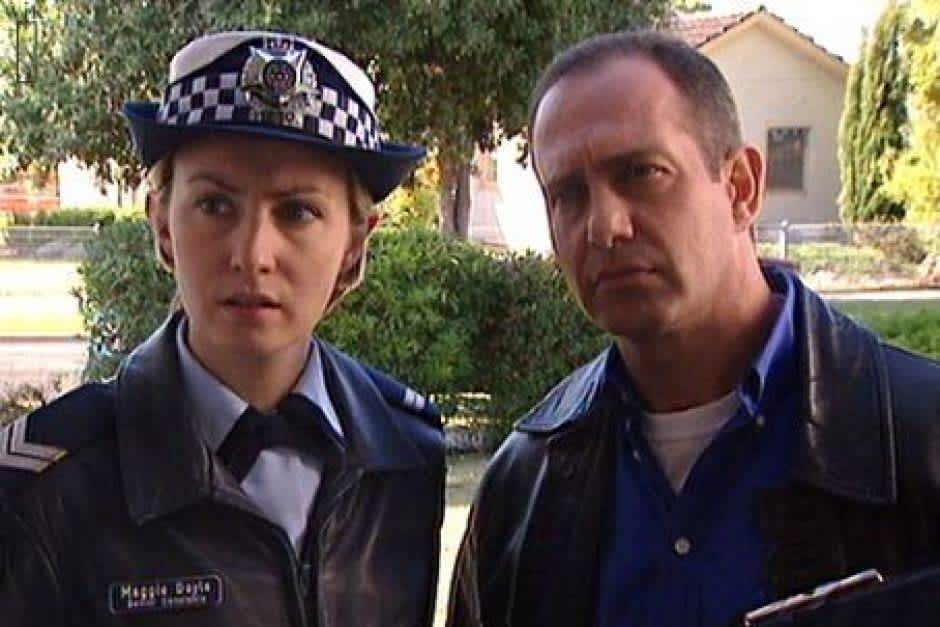For ’90s kids, Australian actor Martin Sacks was best known as PJ Hasham in Blue Heelers.
With a career spanning some forty years (yes, you read that right), Sacks has shed the image of clean-shaven Detective Senior Constable Patrick Joseph ‘PJ’ Hasham and replaced him with more gritty characters from Mario Condello in Underbelly to Derek Channing on Wentworth and now, a role of grieving father in new Australian Netflix film, Sweet River.
The haunting movie centres around Hanna (Lisa Kay) who returns to the sleepy town of Billins, nestled deep in the sugar cane fields, where her four-year-old son Joey was abducted by notorious serial killer Simpkins (Jack Ellis) and is now presumed dead.
On hearing the news that Simpkins had died and her son’s DNA was found on his property, the emotionally damaged Hanna rents a small farmhouse in the valley near to where Simpkins lived and mounts her own investigation.
Her next-door neighbours, John (Sacks) and Elenore Drake (Genevieve Lemon) own the surrounding cane fields and as the official synopsis reads: “John and Elenore are strangely cold and distant, and the townsfolk are also hostile, viewing Hanna as a meddling outsider disturbing their tightly knit farming community.”
For Sacks, who starred in Blue Heelers from 1994-2005, shedding his most famous role in the iconic series required him to quietly disappear from the screen for a few years.
“You have to reinvent yourself. You just have to walk away and almost go quiet, intentionally go quiet,” he said in an interview with The Latch.
“When I came back, I just chose roles that were different and more character-based roles. If you’ve been on a long show, you’ve just got to almost reinvent yourself by choosing wisely and do things that are unexpected and even smaller roles.”
His turn as John in Sweet River is a far-cry away from (“the highest crime rate in the world”) Mount Thomas and deals with the grief that comes losing someone you love.
“I think what was interesting was that his experience was based on the loss of a child. Not that I’ve experienced that horror, but I supposed that was my anchor and my through-line — what would you do? How do you ever come back from that? How do you survive the unsurvivable?”
Here, Sacks talks to The Latch about staying the night at “Hanna’s house” before filming, why the crew is the backbone of the Australian film and TV industry and if he would consider bringing PJ back to life.
Anita Anabel: Hi Martin, it is such a treat to chat with you today. Let’s talk about Sweet River. What was it like to play a role such as John?
Martin Sacks: You know, it’s all character for me now, and something that I’m thoroughly enjoying is the beauty of getting to play these very interesting, multi-layered characters and I love it.
AA: I’m interested in the fact that your characters are “bonded by grief”. Did you use any personal history to help portray John?
MS: No, nothing. The actor’s best friend is imagination and I guess it’s based on the old “what if’s”. As an actor, your job is to really investigate, what would it be like? Do you ever survive that mentally? And also as a couple, so I guess the imagination was what I really drew on.
Also, where we were shooting in Congdon, which is near Murwillumbah in Northern NSW, it was very ominous. It’s got all of those cane fields and creates a real ambience aesthetically so it gets you in the right feeling.
AA: I spoke to Lisa [Kay] and she told me you stayed in the house for a few nights early on in the piece. Did you experience anything there?
MS: When we were fleshing the script out and working on the drafts and throwing ideas around, we all stayed in the house. Lisa, Justin McMillan [director] and Ashley McLeod [producer]. We wanted to have that experience to see what is it like when you wake up in the morning and you see that light and the mist and experience what is it like at sunrise and what’s it like at sunset and what it feels like being in that house in the middle of the night.
We listened for the sounds, and the sugar cane was a very interesting thing because, with the wind in cane, it is incredibly ominous.
AA: What kind of noise does it make?
MS: It is a sort of whooshing sound and it’s a very otherworldly experience. It was so invaluable staying there and getting that sense of isolation in that way.
It was a brilliant location and team and we all just jumped in and tried to contribute.
AA: So, you’ve been doing this job for over three decades…
MS: Closer to 40 years! I’ve loved the aspect of crews. It’s like joining a circus. I’m so happy that everyone has pushed through this tie and all these creatives are able to continue and make more great work.
I love working with the crews. I think they are the salt of the earth. They never get a shout out and they deserve it. We can’t do a thing without him.
AA: Given that you’ve been in the industry for so long, how has it changed since you started?
MS: The advent of streaming has allowed there to be longer-form storytelling. I think the quality of the work in streaming has been extraordinary in terms of what’s on offer.
I do really want the cinema to come back though because it’s such a communal experience that we share as human beings and there is nothing quite like it.
Streamers have been amazing, especially over the pandemic, but I find that the cinema is something that you can’t duplicate that experience, especially if you’re all experiencing something together in a room, without any interruptions.
AA: You played an iconic character, PJ, on an iconic show, Blue Heelers. How did you break away from that role to progress in your career?
MS: That’s such a great question. You have to reinvent yourself. You just have to walk away and almost go quiet, intentionally go quiet.
You don’t accept work immediately. I went into directing. I started directing Blue Heelers and then I did about six or seven episodes of All Saints, so I went behind-the-scenes.
When I came back, I just chose roles that were different and more character-based roles. If you’ve been on a long show, you’ve just got to almost reinvent yourself by choosing wisely and do things that are unexpected and even smaller roles.
AA: Is Blue Heelers the one show you’re most recognised from?
MS: Depends on the vintage! (Laughs) Blue Heelers was the ’90s but my kids who are 20 and 19 would have no idea.
AA: I was a ’90s kid. I absolutely loved you in that show! In fact, interviewing you means more to me than a US movie star. I think because I grew up with you on TV.
MS: Thank you! It was such a blessing for me, for all of us. It was like making a home movie with friends. Every day you go in there and you love the people and the work was fun. I mean, we were working with the highest crime rate in the world in Mount Thomas! (Laughs).
It was a time when there was no computer and there was no web. So, if you wanted to watch your program at 8.30 pm on a Tuesday night, then you had to be home…and if you tried to video it, you always messed it up. You got to sit around as a family, be at home and watch your favourite program.
AA: Do you think you’d ever do Blue Heelers again?
MS: I don’t know. I mean, there’s a part of me that says it’s done. There are sort of whispers of that, that people want it but I’m not sure.
Sometimes you have such a fabulous memory of events that happen in your life and you and you’re trying to revisit that and it doesn’t necessarily come up. I haven’t really thought about that though. I like moving forward and trying to do other things.
AA: What keeps you passionate about acting and what types of stories do you want to tell?
MS: What gives you passion is just working with creative people with fresh ideas. Then you get a whole bunch of people together. It’s a collaboration. I like the collaboration. I’d never exist in a situation just sitting in the backroom writing a script or novel. I love the idea of the people and coming together and ultimately, the best idea wins.
Stream Sweet River on Netflix n








